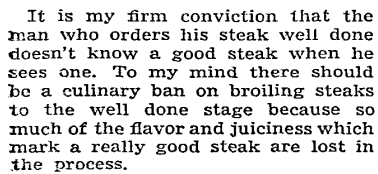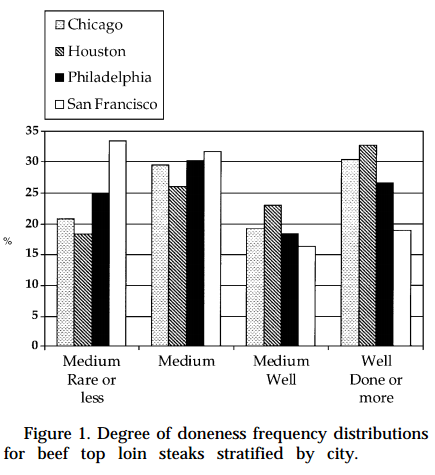I've been oddly obsessed with President Trump's affinity for well-done steak. Not because I have a dog in this fight—it actually made me want a well-done steak, since it's been awhile—but because of the intersection of food and culture that turns up in pieces like Helen Rosner's for Eater.
Based on Twitter anecdata, it seemed like steak temperature preference might be generational, and that age correlates with doneness. So I started poking around. As you might expect, Chicago, once home to the great stockyard of America and still a huge consumer-research center, would turn up data on the subject.
First, food writers lecturing diners on their preference for extreme doneness is not a product of (for lack of a better word) new foodie culture. This is from a 1936 column by "Mary Meade," the pen name of five Chicago Tribune food editors from 1930 to 1974; given the year the column ran, it was likely written by the influential Ruth Ellen Church.

But Meade's advice fell on deaf ears. In 1950, the National Livestock and Meat Board presented a consumer study at the International Livestock Exposition in Chicago, which surveyed 96,000 people in 48 states. More than half of people (56 percent) ate their beef well done; 37 percent medium; just seven percent ate it rare despite, as the Tribune article noted, "epicures' conviction that it is at its best when served rare." Perhaps Meade had some local impact, though; 17 percent of Chicagoans preferred rare beef.
Over the next half-century, things moved slowly in the epicurean direction. In 1999 researchers from the Department of Animal Science at Texas A&M surveyed people in four cities about their preference for cooking top loin, a high-end cut. Now there was a fairly even distribution of doneness preference.

San Franciscans were far more likely to prefer rare steak. A good case can be made that the city was well ahead of Chicago at the time in terms of fine dining; in 1982, Florence Fabricant of the New York Times found that, in the post-Julia Child era, preferences were shifting towards rare meat, beginning on the coasts.
And that shift seems to have continued. A 2010 study from Texas Tech of over 1,300 people in Phoenix, Baltimore/Washington, and Lubbock, Texas, found that the preference for well-done steaks was just 9.9 percent. More than 30 percent of respondents preferred medium-rare or less (27 percent medium-rare, four percent rare) as tastes became more like those of San Francisco.
FiveThirtyEight did a survey in 2014, and though the sample was small, the numbers were somewhat similar: just eight percent preferred well-done steaks, while 43 percent preferred medium-rare (38 percent) or rare (five percent).
Very slowly, America is coming around to Ruth Ellen Church. As far as putting ketchup on your steak, you probably don't need to bother surveying Chicagoans about that.



